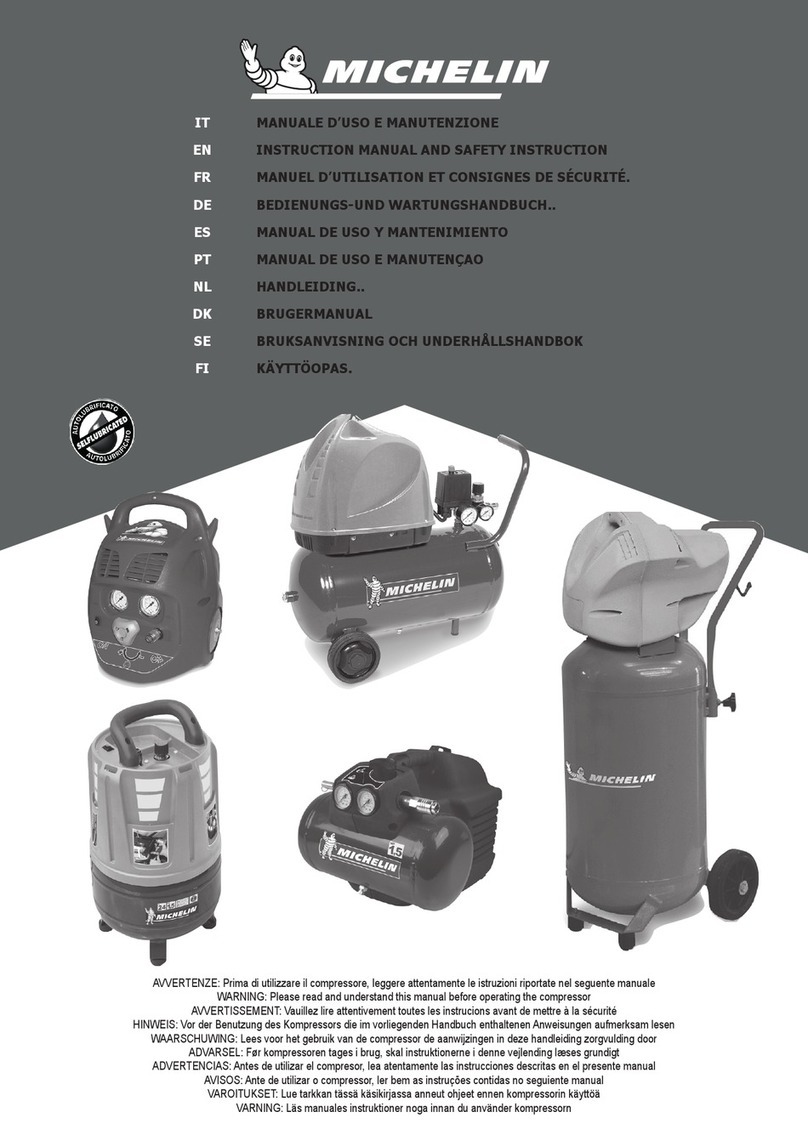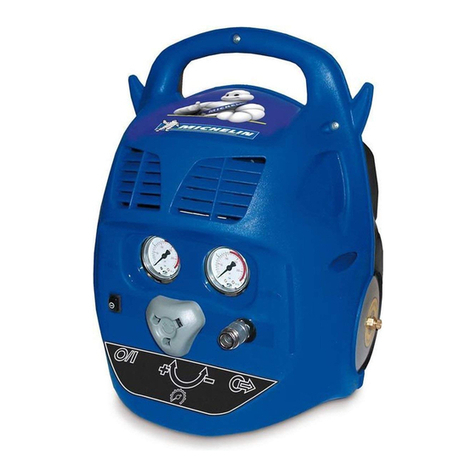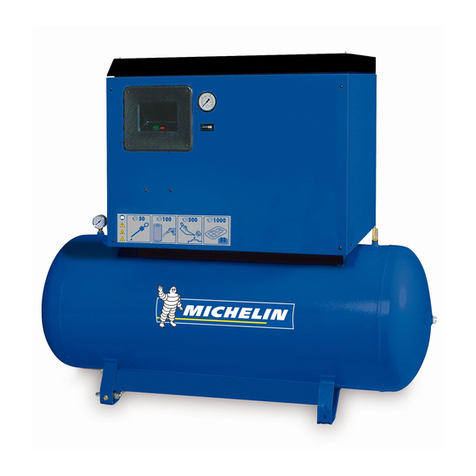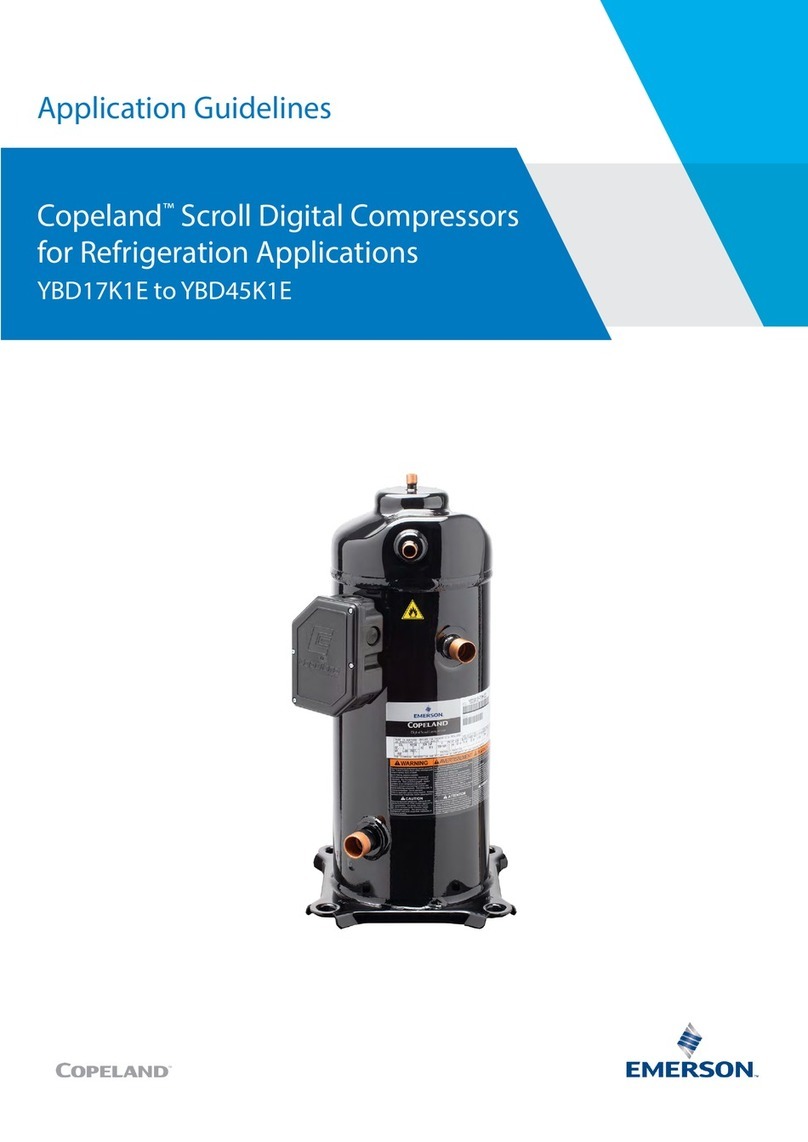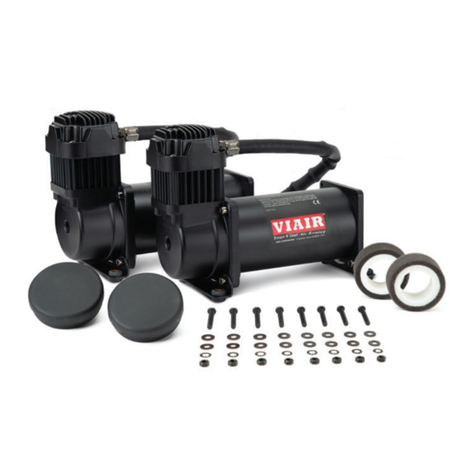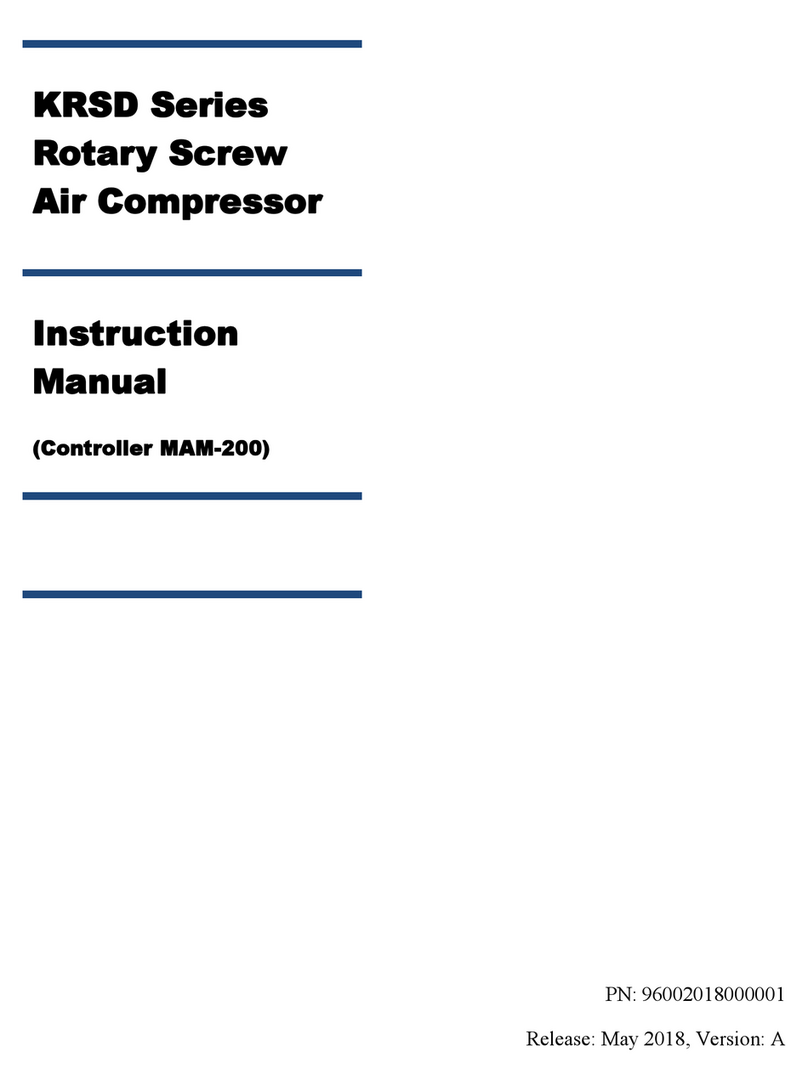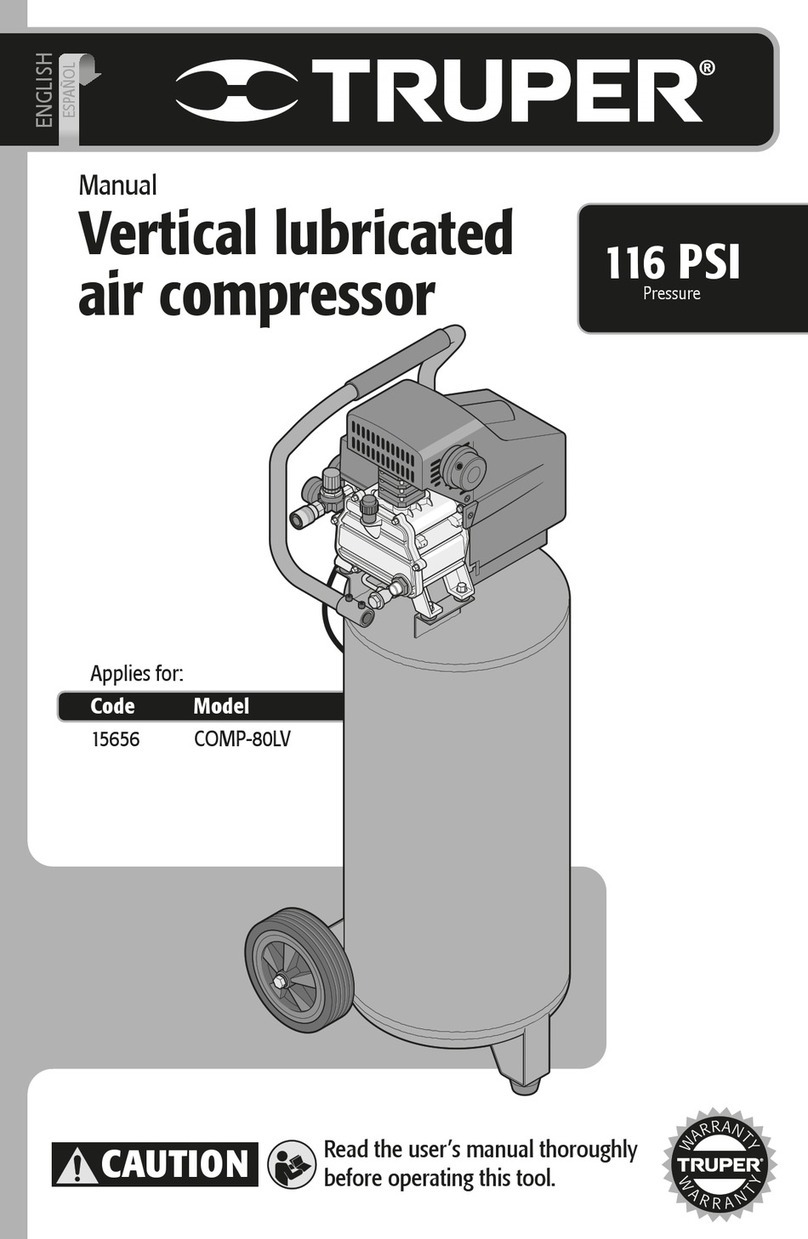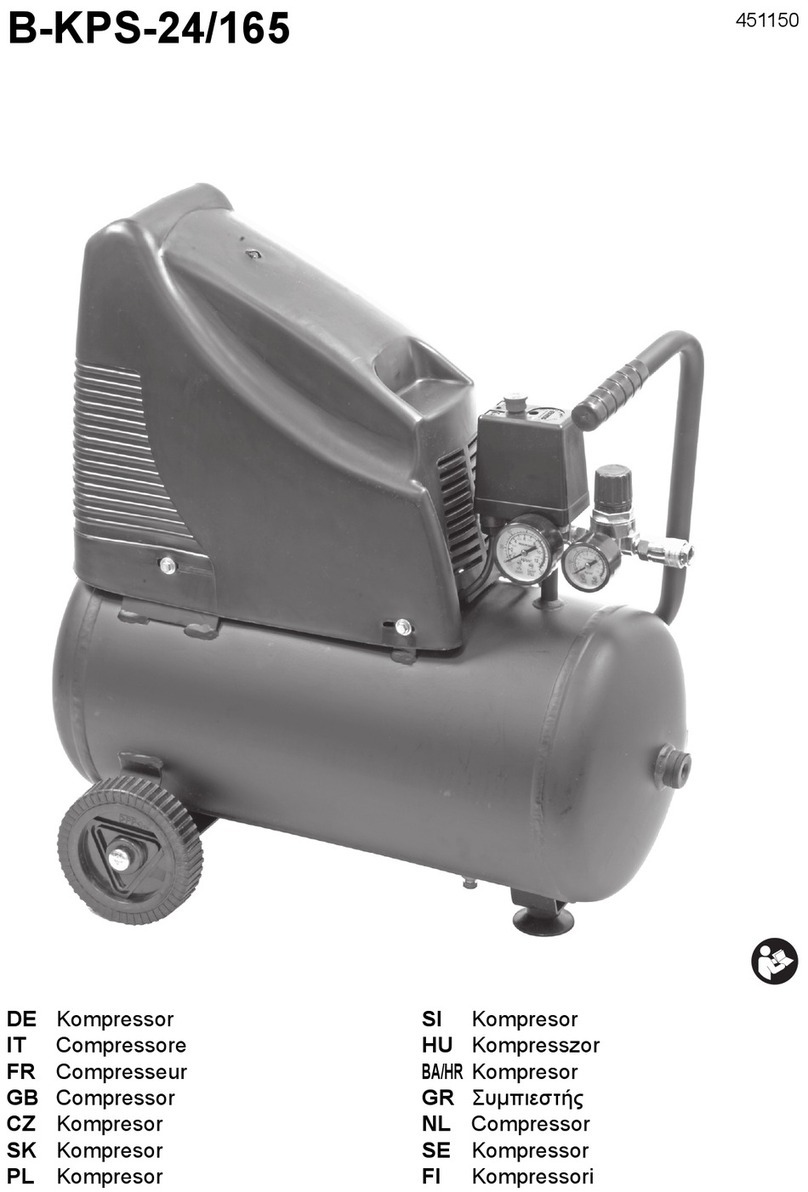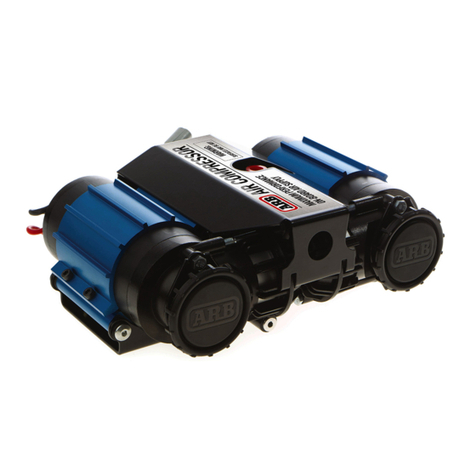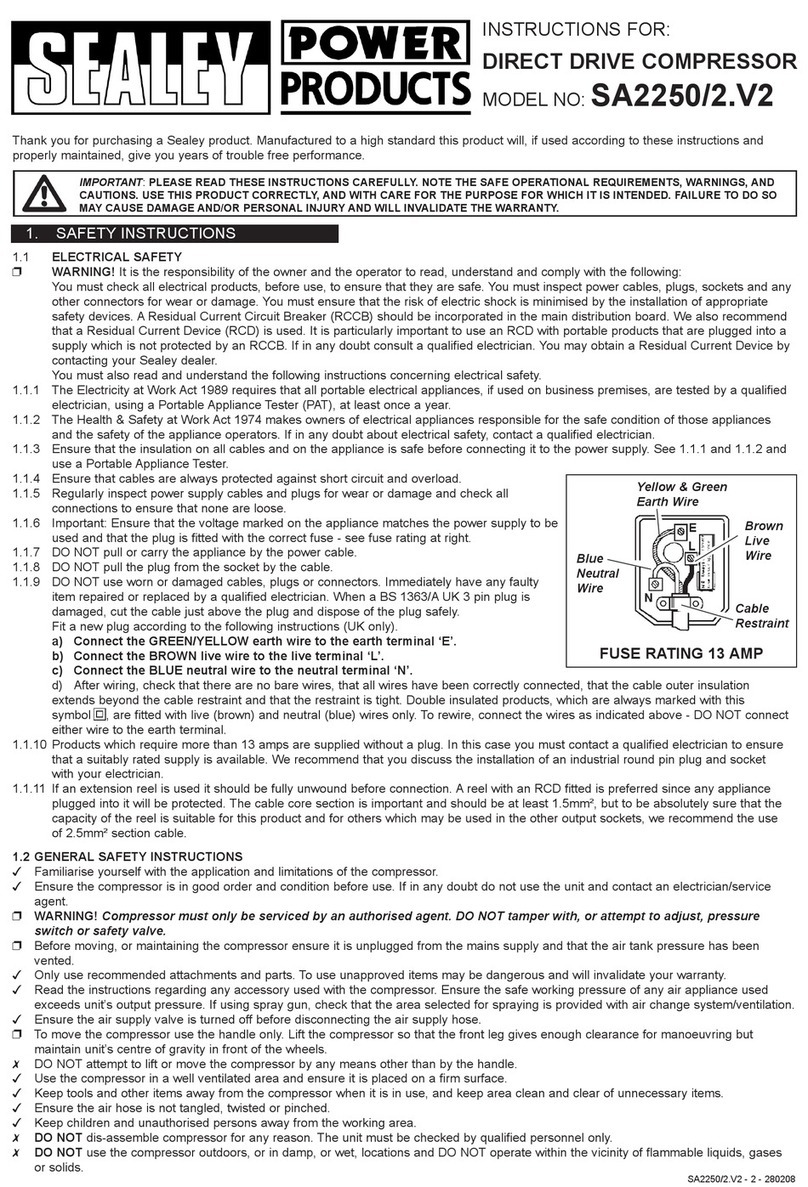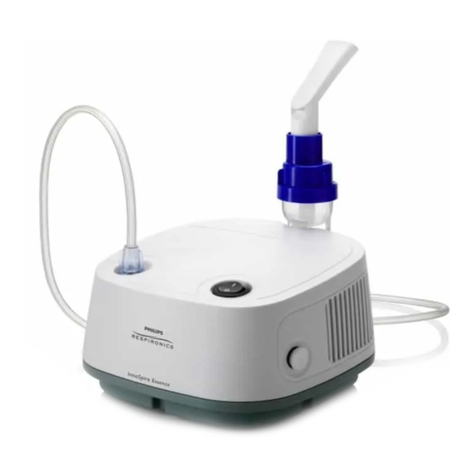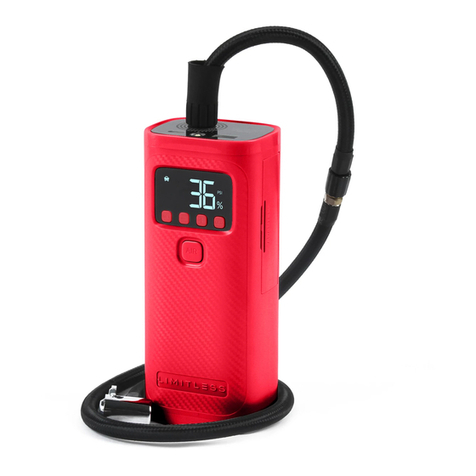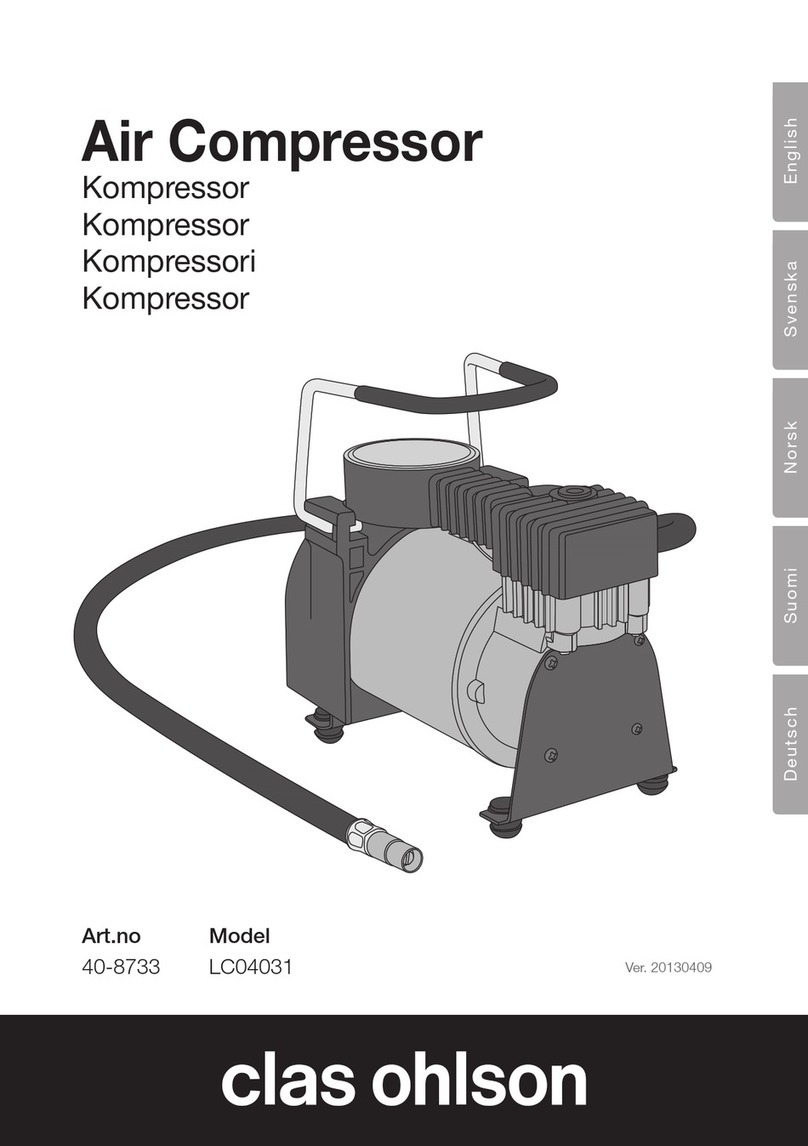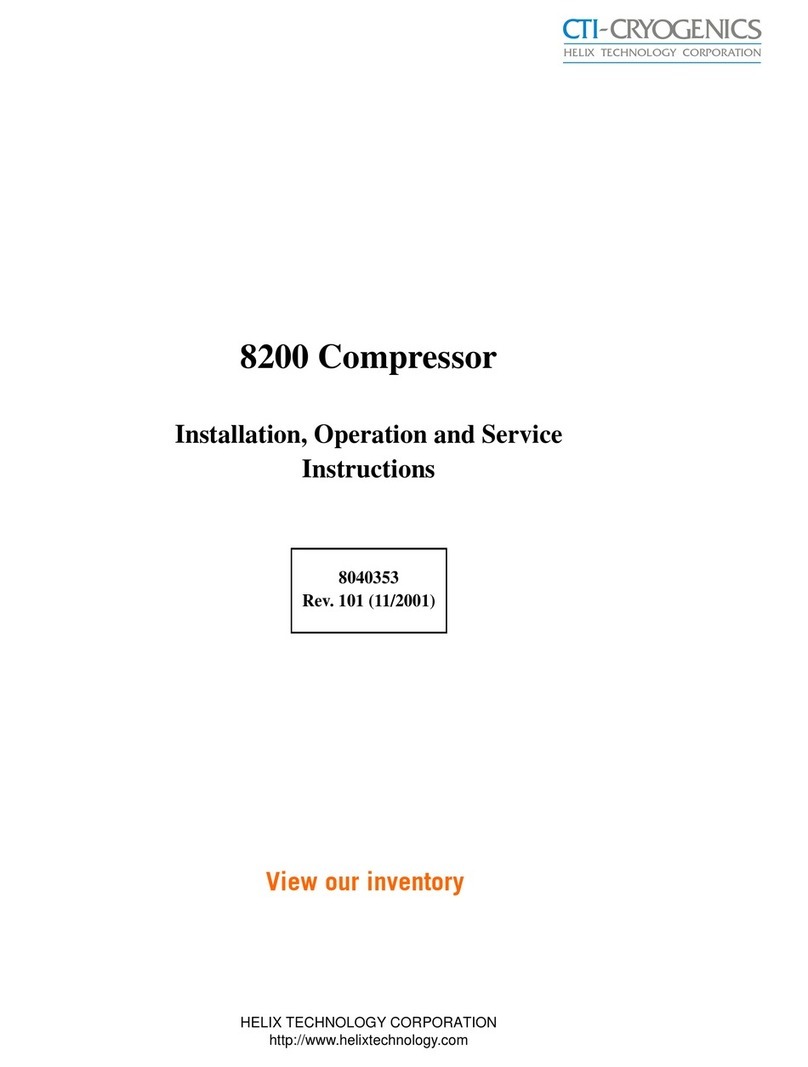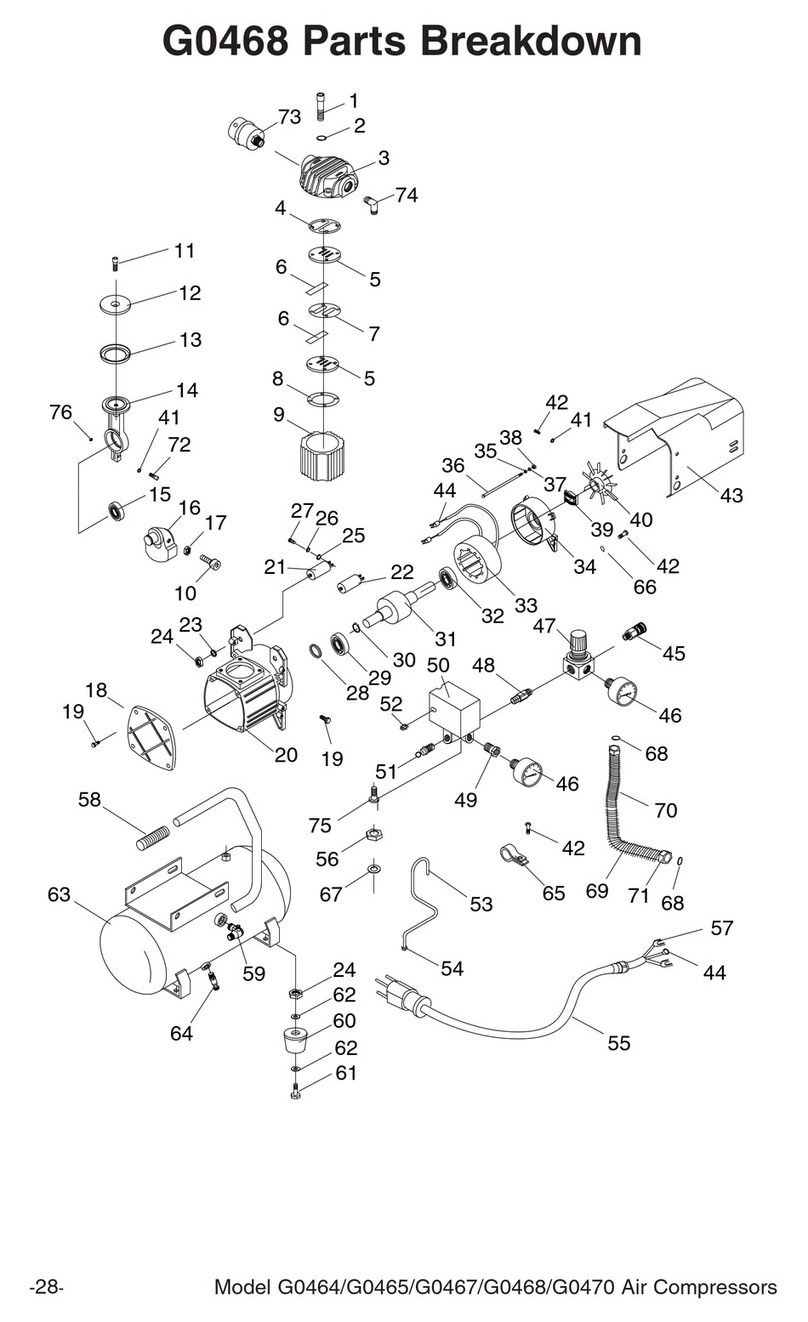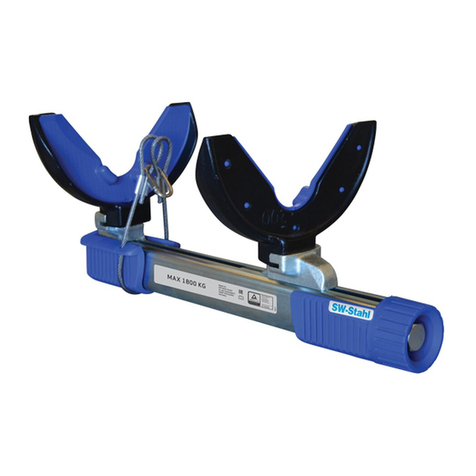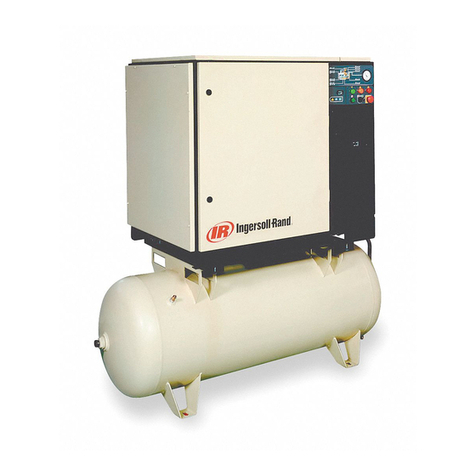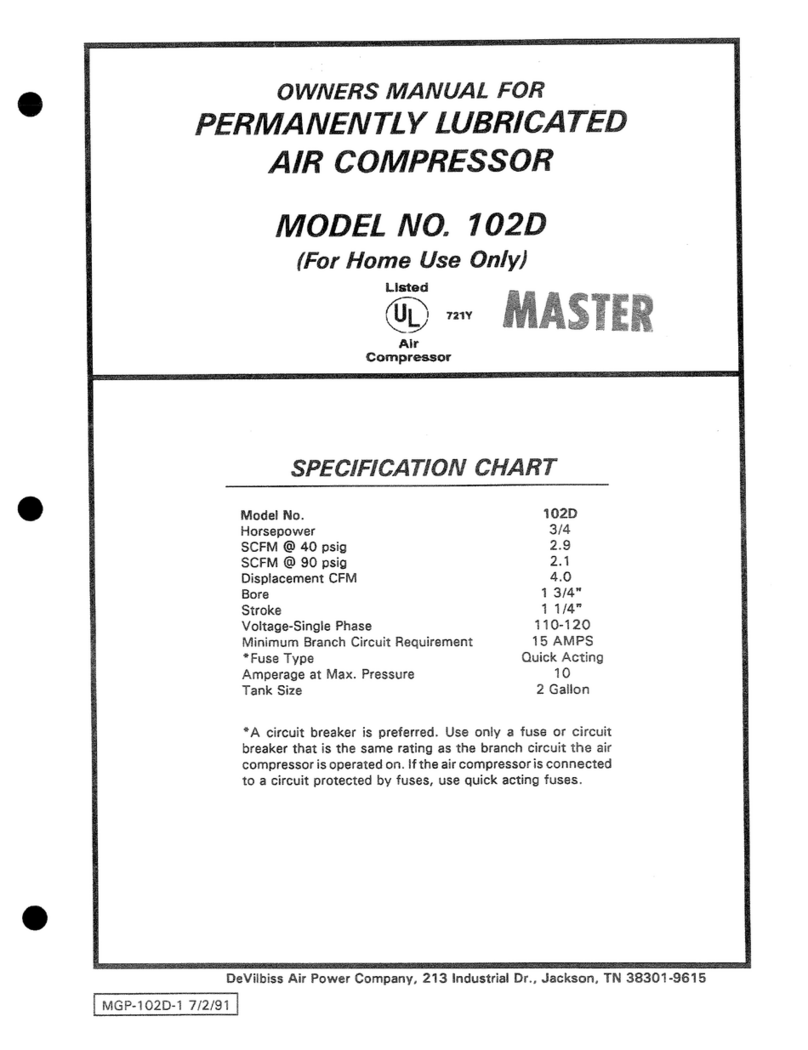Michelin MX6 User manual

Type: 1127341142
12/2020
A5
AIR COMPRESSOR
MX 6 - MX 10 - MX 24 - MX 50
Manuale d’uso Compressore d’aria
User Guide Air Compressor
Notice d’utilisation du Compresseur
Betriebsanleitung Druckluftkompressor
Manual de uso del Compresor de aire
Manual de uso Compressor de ar
Gebruikshandleiding voor luchtcompressor
Brugsanvisning til luftkompressor
Luftkompressorns instruktionsbok
Ilmakompressorin käyttäjän opas
компрессора
IT
EN
FR
DE
ES
PT
NL
DK
SE
FI
RU

2
AVVERTENZE: Prima di utilizzare il compressore, leggere attentamente le istruzioni riportate nel seguente manuale.
WARNING: Before using the compressor, please read the instructions in this manual carefully.
AVERTISSEMENTS: Avant d’utiliser le compresseur, lire attentivement les instructions de cette notice d’instructions.
VORSICHT: Vor der Benutzung des Kompressors die in diesem Handbuch stehenden Anweisungen aufmerksam lesen.
ADVERTENCIA: Antes de utilizar el compresor, leer atentamente las instrucciones presentes en el siguiente manual.
AVISOS: Antes de utilizar o compressor, ler bem as instruções contidas no seguinte manual.
WAARSCHUWINGEN: Lees voor het gebruik van de compressor de aanwijzingen in deze handleiding zorgvuldig door.
ADVARSEL: Før du bruger kompressoren, skal du læse instruktionerne i denne vejledning grundigt.
VIKTIG INFORMATION: Innan du använder kompressorn ska du noggrant läsa igenom instruktionerna i den här instruktionsboken.
VAROITUKSIA: Lue huolellisesti tässä käsikirjassa annetut ohjeet ennen kompressorin käyttöä.
: .

3
1127341142 - 10/2020
IT
ISTRUZIONI D’USO
8
EN
USER GUIDE
14
FR
NOTICE D’UTILISATION
19
DE
BEDIENUNGSANLEITUNG
25
ES
INSTRUCCIONES DE USO
31
PT
MANUAL DE UTILIZAÇAO
37
NL
GEBRUIKSAANWIJZING
43
DK
BRUGERVEJLEDNING
49
SE
ANVÅNDARGUIDE
55
FI
KÄYTTÖOHJEET
60
RU
ГИД ПОЛЬЗОВАТЕЛЯ
65

4
IT
LEGGERE IL LIBRETTO DI ISTRUZIONI - Prima di posizionare, mettere in funzione o
intervenire sul compressore, leggere attentamente il libretto istruzioni.
EN
READ THE INSTRUCTION HANDBOOK - Before positioning, operating or adjusting the
compressor, read the instruction handbook carefully.
FR
LIRE LA NOTICE D’INSTRUCTIONS - Avant de positionner, de mettre en marche ou
d’intervenir sur le compresseur, lire attentivement la notice d'instructions.
DE
DIE BETRIEBSANLEITUNG LESEN - Lesen Sie die Betriebsanleitung sorgfältig durch, bevor
Sie den Kompressor aufstellen, in Betrieb nehmen oder Eingrie daran vornehmen.
ES
LEER EL MANUAL DE INSTRUCCIONES - Antes de posicionar, poner en funcionamiento o
intervenir en el compresor, leer atentamente el manual de instrucciones.
PT
LER O MANUAL DE INSTRUÇÕES - Antes de colocar, pôr a funcionar ou intervir no
compressor, ler atentamente este manual de instruções.
NL
LEES HET INSTRUCTIEBOEKJE - Lees het instructieboekje aandachtig alvorens de
compressor te plaatsen, inwerking te stellen of er werkzaamheden aan te verrichten.
DK
LÆS INSTRUKTIONSBOGEN - Før du placerer, starter eller arbejder på kompressoren, skal
du læse instruktionsbogen omhyggeligt.
SE
LÄS BRUKSANVISNINGEN - Läs igenom instruktionsboken innan installation, igångsättning
eller åtgärder på kompressorn.
FI
LUE OHJEKIRJA - Lue ohjekirja huolellisesti ennen kompressorin sijoittamista, käyttöön
ottamista tai toimenpiteiden suorittamista.
RU
ПРОЧИТАЙТЕ РУКОВОДСТВО ПО ЭКСПЛУАТАЦИИ - , ,
,
.
IT
RISCHIO SHOCK ELETTRICO Attenzione: prima di qualsiasi intervento staccare
l’alimentazione.
EN
RISK OF ELECTRIC SHOCK
- Caution: disconnect power supply before attempting any
maintenance.
FR
RISQUE D’ÉLECTROCUTION - Attention: avant toute intervention, débranchez
l'alimentation électrique.
DE
GEFAHR DURCH ELEKTRISCHE SPANNUNG - Vorsicht! Schalten Sie vor jedem Eingri die
Stromzufuhr aus.
ES
RIESGO DE DESCARGA ELÉCTRICA - Atención: antes de cualquier intervención desconectar
la alimentación.
PT
PERIGO DE CHOQUE ELÉTRICO - Atenção: antes de efetuar qualquer intervenção no
compressor é obrigatório desligar a alimentação elétrica.
NL
GEVAAR VOOR ELEKTRISCHE SCHOK - Let op: schakel de stroomtoevoer uit alvorens
werkzaamheden uit te voeren.
DK
RISIKO FOR ELEKTRISK STØD - Advarsel: Afbryd strømforsyningen inden ethvert indgreb.
SE
RISK FÖR ELCHOCK - Varning: innan någon som helst åtgärd ska strömmen kopplas bort.
FI
SÄHKÖISKUN VAARA - Huomio: ennen minkään toimenpiteen suorittamista katkaise
virransyöttö.
RU
ОПАСНОСТЬ ПОРАЖЕНИЯ ТОКОМ - !
.

5
IT
RISCHIO DI TEMPERATURE ELEVATE Attenzione: nel compressore ci sono alcune parti che
potrebbero raggiungere temperature elevate.
EN
RISK OF HIGH TEMPERATURES - Caution: the compressor contains some parts which might
reach high temperatures.
FR
RISQUE DE TEMPÉRATURES ÉLEVÉES - Attention: certaines parties du compresseur
peuvent atteindre des températures élevées.
DE
GEFAHR DURCH WÄRME - Vorsicht! Im Kompressor benden sich einige Teile, die sich stark
erhitzen können.
ES
RIESGO DE TEMPERATURAS ELEVADAS - Atención: en el compresor existen algunas partes
que podrían alcanzar temperaturas elevadas.
PT
PERIGO DE TEMPERATURAS ELEVADAS - Atenção: no compressor existem algumas partes
que poderão alcançar temperaturas elevadas.
NL
GEVAAR VOOR HOGE TEMPERATUREN - Let op: in de compressor kunnen sommige
onderdelen hoge temperaturen bereiken.
DK
RISIKO FOR HØJE TEMPERATURER - Advarsel: nogle dele af kompressoren kan nå høje
temperaturer.
SE
RISK FÖR HÖG TEMPERATUR - Varning: i kompressorn nns det vissa delar som kan
överhettas.
FI
KORKEIDEN LÄMPÖTILOJEN VAARA - Huomio: jotkut kompressori osat voivat tulla erittäin
kuumiksi.
RU
ОПАСНОСТЬ ОЖОГА - !
.
IT
RISCHIO DI PARTENZA ACCIDENTALE Attenzione: il compressore potrebbe ripartire in caso
di black-out e successivo ripristino di tensione.
EN
RISK OF ACCIDENTAL START-UP - Caution: the compressor could start automatically after a
power cut if not switched o.
FR
RISQUE DE DÉMARRAGE ACCIDENTEL - Attention: après une coupure de courant, le
compresseur risque de redémarrer lors du rétablissement du courant.
DE
GEFAHR DURCH UNERWARTETEN ANLAUF - Vorsicht! Der Kompressor kann nach einen
Stromausfall automatisch anlaufen, wenn er nicht ausgeschaltet wurde.
ES
RIESGO DE ARRANQUE ACCIDENTAL - Atención: el comprensor podría arrancar en caso de
apagón y posterior retorno de la tensión.
PT
PERIGO DE ARRANQUE ACIDENTAL - Atenção: o compressor poderá começar a funcionar
após uma falta de corrente quando esta voltar.
NL
RISK FÖR OAVSIKTLIG START - Varning: kompressorn kan starta om vid ett strömavbrott
eller efter en återställning av spänningen.
DK
RISIKO FOR UTILSIGTET IGANGSÆTTELSE - Advarsel: kompressoren kan genstarte
utilsigtet i tilfælde af strømafbrydelse når strømmen efterfølgende vender tilbage.
SE
RISK FÖR OFRIVILLIG START Varning! Kompressorn kan automatiskt starta om när
strömmen återställs efter ett strömavbrott.
FI
VAHINGOSSA KÄYNNISTYMISEN VAARA - Huomio: kompressori saattaa käynnistyä
uudelleen, kun jännite palautuu sähkökatkoksen jälkeen.
RU
ОПАСНОСТЬ ПРОИЗВОЛЬНОГО ЗАПУСКА - !
.

6
1
SERBATOIO / TANK / RESERVOIR / TANK / DEPÓSITO / DEPÓSITO / TANK / TANK / TANK / SÄILIÖ /
2
SCARICO CONDENSA / CONDENSATE DRAIN /EVACUATION CONDENSATION /KONDENSATABLASS / DESCARGA CONDENSACIÓN / PURGA
DA CONDENSAÇÃO/ CONDENSAFTAP / KONDENSUDLUFTNING / TÖMNING AV KONDENS / KONSENSSIVEDEN TYHJENNYS / -
3
FILTRO ARIA / AIR FILTER / FILTRE A AIR / LUFTFILTER / FILTRO AIRE / FILTRO DE AR / LUCHTFILTER / LUFTFILTER / LUFTFILTER /
ILMANSUODATIN /
4
VALVOLA DI NON RITORNO / CHECK VALVE/CLAPET ANTI-RETOUR / RÜCKSCHLAGVENTIL / VÁLVULA ANTIRRETORNO / VÁLVULA DE NÃO
RETORNO / TERUGSLAGKLEP / KONTRAVENTIL / BACKVENTIL / TAKAISKUVENTTIILI /
5
PRESSOSTATO / PRESSURE SWITCH /PRESSOSTAT / DRUCKWÄCHTER / PRESÓSTATO / PRESSÓSTATO / DRUKSCHAKELAAR / TRYKREGULA-
TOR / TRYCKMÄTARE / PAINEENSÄÄDIN /
6
RIDUTTORE DI PRESSIONE / PRESSURE REDUCER / REDUCTEUR DE PRESSION / DRUCKMINDERER / REDUCTOR DE PRESIÓN / REDUTOR DE
PRESSÃO / REDUCEERAFSLUITER / TRYKREDUKTIONSVENTIL / REDUCERVENTIL / PAINEENALENNIN /
7
MANOMETRO / PRESSURE GAUGE / MANOMÈTRE / MANOMETER / MANÓMETRO / MANÓMETRO / MANOMETER / MANOMETER / MANO-
METER / PAINEMITTARI /
8
USCITA ARIA COMPRESSA RIDOTTA / REDUCED COMPRESSED AIR OUTLET / SORTIE D’AIR COMPRIMÉ RÉDUIT / REDUZIERTER DRUCK-
LUFTAUSGANG / SALIDA DEL AIRE COMPRIMIDO REDUCIDA / SAÍDA AR COMPRIMIDO REDUZIDA / UITLAAT GEREDUCEERDE PERSLUCHT
/ UDGANG TIL LUF MED REDUCERET TRYK / MINSKAD TRYCKLUFTSUTGÅNG / PAINEILMAN ALENNUKSEN ULOSTULO / -
9
VALVOLA DI SICUREZZA / SAFETY VALVE / SOUPAPE DE SÉCURITÉ / SICHERHEITSVENTIL / VÁLVULA DE SEGURIDAD / VÁLVULA DE SEGU-
RANÇA / VEILIGHEIDSKLEP / SIKKERHEDSVENTIL / SÄKERHETSVENTIL / VAROVENTTIILI /
10 TASTO RESET / RESET BUTTON / BOUTON DE REMISE A ZÉRO /RESET-TASTE /TECLA RESET /TECLA RESET /
RESET-KNOP / TASTEN
RESET / ÅTERSTÄLLNINGSKNAPP / RESETOINTIPAINIKE /
3
3
9
1
1
10
5
4
9
1
2
22
9867
5
7
6
83
4
7
6
8
5
4

7
Tab. A
Volt 220-240 110-120
kW / HP mm² (*) mm² (*)
0,75 / 1 1,5 2,5
(*)
Sezione valida per una lunghezza massima di 20 m
Cable cross-section for maximum length 20 m
Section valable pour une longueur maximale de 20 m
Querschnitt gilt für max. Länge von 20 m
Sección válida para una longitud máxima de 20 m
Secção válida para um comprimento máximo de 20 m
Geldige doorsnede voor een maximale lengte van 20 m
Sektion gyldig til en maksimal længde på 20 m
Tvärsnitt för max längd på 20 m
Sallittu poikkileikkaus johdolle, jonka pituus on enintään 20 m
20
Tab. B
L 6 10 24 50
V220-240/50
bar / psi 8 / 116
rpm 1450
kW/HP 0,75 / 1
l/min 130
db(A) LwA 78
kg 15,5 22 19 28
mm
375x330x335
(6L)
400x335x620 (10L)
558x240x525
(24L)
770x380x570
(50 L)

8
IT
1. NORME DI SICUREZZA
1.1 INFORMAZIONI IMPORTANTI
Leggere attentamente tutte le istruzioni di
funzionamento, i consigli per la sicurezza e le
avvertenze del manuale di istruzioni.
La maggioranza degli incidenti durante l’uso del
compressore, sono dovuti al non rispetto delle
elementari regole di sicurezza. Identicando in tempo
le potenziali situazioni pericolose e osservando le
regole di sicurezza appropriate, si eviteranno incidenti.
Le regole fondamentali per la sicurezza sono elencate
nella sezione“SICUREZZA”di questo manuale.
Le situazioni pericolose da evitare per prevenire tutti
i rischi di lesioni gravi o danni alla macchina sono
segnalate nella sezione“AVVERTENZE”.
Non utilizzare mai il compressore in modo
inappropriato, ma solo come consigliato dalla casa
costruttrice.
AVVERTENZE: indica una situazione potenzialmente
pericolosa che, se ignorata, può provocare gravi danni.
PRECAUZIONI: indica una situazione pericolosa che,
se ignorata, può provocare leggeri danni alle persone e
alla macchina.
NOTA: sottolinea un’informazione essenziale.
1.2 NORME DI SICUREZZA
L’UTILIZZO INAPPROPRIATO E LA CATTIVA
MANUTENZIONE DI QUESTO COMPRESSORE
POSSONO PROVOCARE LESIONI FISICHE. PER
EVITARE QUESTI RISCHI SI PREGA DI SEGUIRE
ATTENTAMENTE LE SEGUENTI ISTRUZIONI.
1. NON TOCCARE LE PARTI IN MOVIMENTO
Non mettere mai le vostre mani, dita o altre parti del
corpo vicino a parti in movimento del compressore.
2. NON USATE IL COMPRESSORE SENZA LE PROTEZIONI
MONTATE
Non usare mai il compressore senza che tutte le
protezioni siano perfettamente montate al proprio
posto (es. carenature, paracinghia, valvola di sicurezza)
se la manutenzione o il servizio richiedono di
rimuovere queste protezioni assicuratevi che prima
di utilizzare nuovamente il compressore le protezioni
siano ben ssate al posto originale.
3. UTILIZZARE SEMPRE OCCHIALI DI PROTEZIONE
Utilizzare sempre occhiali o equivalenti protezioni
per gli occhi. Non indirizzare l’aria compressa verso
nessuna parte del corpo proprio o di altri.
4. PROTEGGI TE STESSO CONTRO GLI SHOCK ELETTRICI
Prevenire contatti accidentali del corpo con le parti
metalliche del compressore come tubi, serbatoio o
parti di metallo collegate a terra. Non usare mai il
compressore in presenza di acqua o di ambienti umidi.
5. SCOLLEGARE IL COMPRESSORE
Scollegare il compressore dalla fonte elettrica e
scaricare completamente il serbatoio dalla pressione
prima di eettuare qualsiasi servizio, ispezione,
manutenzione, pulizia rimpiazzo o controllo di ogni
parte.
6. PARTENZE ACCIDENTALI
Non trasportare il compressore mentre è collegato alla
fonte elettrica o quando il serbatoio è sotto pressione.
Assicurarsi che l’interruttore del pressostato sia nella
posizione OFF prima di collegare il compressore alla
fonte elettrica.
7.
STOCCARE IL COMPRESSORE IN MANIERA APPROPRIATA
Quando il compressore non è utilizzato deve essere
tenuto in un locale secco al riparo dagli agenti
atmosferici. Tenere lontano dai bambini.
8. AREA DI LAVORO
Tenere la zona di lavoro pulita eventualmente liberare
l’area da utensili non necessari. Tenere l’area di lavoro
ben ventilata. Non usare il compressore in presenza
di liquidi inammabili o gas. Il compressore può
produrre scintille durante il funzionamento. Non usare
il compressore in situazioni dove si possono trovare
vernici, benzine, sostanze chimiche, adesivi e ogni altro
materiale combustibile o esplosivo.
9. TENERE LONTANO I BAMBINI
Evitare che bambini o qualsiasi altra persona entri in
contatto con il cavo di alimentazione del compressore,
tutti gli estranei devono essere tenuti ad una distanza
di sicurezza dalla zona di lavoro.
10. INDUMENTI DI LAVORO
Non indossare abiti voluminosi o gioielleria, questi
potrebbero essere catturati dalle parti in movimento.
Indossare cue che coprano i capelli se necessario.
11. NON ABUSARE DEL CAVO DI ALIMENTAZIONE
Non collegare la spina di corrente tirando il cavo
di alimentazione. Tenere il cavo lontano dal calore,
dall’olio e da superci taglienti. Non calpestare il cavo
elettrico o schiacciarlo con pesi inadeguati.
1. PREMESSA

9
IT
12. MANTENERE IL COMPRESSORE CON CURA
Seguire le istruzioni per la lubricazione (non valido
per oilless). Ispezionare il cavo di alimentazione
periodicamente e se danneggiato deve essere riparato
o sostituito da un centro assistenza autorizzato.
Vericare l’aspetto esterno del compressore che non
presenti anomalie visive. Rivolgersi eventualmente al
più vicino centro assistenza.
13. PROLUNGHE ELETTRICHE PER UTILIZZO ESTERNO
Quando il compressore è usato esternamente utilizzare
solamente prolunghe elettriche destinate all’uso
esterno e marcate per questo.
14. ATTENZIONE
Fate attenzione a cosa state facendo. Usate il buon
senso comune. Non usate il compressore quando siete
stanchi. Il compressore non deve essere mai usato se
siete sotto l’eetto dell’alcool, droga o medicinali che
possano indurre sonnolenza.
15. CONTROLLARE PARTI DIFETTOSE O PERDITE DI ARIA
Prima di utilizzare nuovamente il compressore, se una
protezione o altre parti sono danneggiate devono
essere controllate attentamente per determinare
se possono funzionare come previsto in sicurezza.
Controllare allineamento di parti in movimento,
tubi, manometri, riduttori di pressione, connessioni
pneumatiche e ogni altra parte che può avere
importanza nel funzionamento normale. Ogni parte
danneggiata deve essere propriamente riparata o
rimpiazzata da un servizio assistenza autorizzato o
sostituito come indicato nel libretto istruzioni. NON
UTILIZZARE IL COMPRESSORE SE IL PRESSOSTATO E’
DIFETTOSO.
16. UTILIZZARE IL COMPRESSORE ESCLUSIVAMENTE
PER LE APPLICAZIONI SPECIFICATE
Il compressore è una macchina che produce aria
compressa. Non utilizzare mai il compressore per
utilizzazioni diverse da quelle specicate nel libretto
istruzioni.
17. USARE IL COMPRESSORE CORRETTAMENTE
Far funzionare il compressore conformemente alle
istruzioni di questo manuale. Non lasciare utilizzare il
compressore ai bambini, alle persone che non hanno
famigliarità con il suo funzionamento.
18. VERIFICARE CHE OGNI VITE, BULLONE E COPERCHIO
SIANO SOLIDAMENTE FISSATI.
Vericare che ogni vite, bullone e targhetta siano
solidamente ssati. Vericare periodicamente che siano
ben stretti.
19. TENERE PULITA LA GRIGLIA DI ASPIRAZIONE
Tenere la griglia di ventilazione del motore pulita.
Pulire regolarmente questa griglia se l’ambiente di
lavoro è molto sporco.
20. FARE FUNZIONARE IL COMPRESSORE ALLA
TENSIONE NOMINALE
Fare funzionare il compressore alla tensione specicata
sulla targhetta dei dati elettrici. Se il compressore è
utilizzato a una tensione superiore di quella nominale,
il motore girerà più velocemente e si può danneggiare
l’unità bruciando il motore.
21.
NON USARE MAI IL COMPRESSORE SE E’DIFETTOSO
Se il compressore lavora emettendo strani rumori
o eccessive vibrazioni o appare difettoso, fermatelo
immediatamente e vericate la funzionalità o
contattate il più vicino centro assistenza autorizzato.
22. NON PULIRE PARTI DI PLASTICA CON SOLVENTI
Solventi come benzina, diluenti, gasolio o altre
sostanze che contengono alcool possono danneggiare
le parti di plastica, non stronare questi componenti
sulle parti in plastica. Pulire eventualmente queste
parti con un panno morbido e acqua saponata o liquidi
appropriati.
23. USARE SOLO PARTI DI RICAMBIO ORIGINALI.
L’utilizzazione di parti di ricambio non originali
provocano l’annullamento della garanzia e un
malfunzionamento del compressore. I pezzi di
ricambio originali sono disponibili presso i distributori
autorizzati.
24. NON MODIFICARE IL COMPRESSORE
Non modicare il compressore. Consultare un centro
assistenza autorizzato per tutte le riparazioni. Una
modica non autorizzata può diminuire le prestazioni
del compressore, ma può anche essere la causa di gravi
incidenti per le persone che non hanno la conoscenza
tecnica necessaria per eettuare delle modiche.
1. PREMESSA

10
IT 1. PREMESSA
25. SPEGNERE QUANDO NON E’UTILIZZATO
Quando il compressore non è in uso, posizionare
la manopola del pressostato in posizione“0”(OFF),
scollegare il compressore dalla corrente e aprire il
rubinetto di linea per scaricare l’aria compressa dal
serbatoio.
26.
NON TOCCARE LE PARTI CALDE DEL COMPRESSORE
Non toccare i tubi, il motore e tutte le altre parti calde.
27.
NON DIRIGERE IL GETTO D’ARIA SUL CORPO
Non dirigere mai il getto d’aria su persone o animali.
28. SCARICO CONDENSA DAL SERBATOIO
Scaricare il serbatoio giornalmente oppure ogni 4 ore
di servizio. Aprire il dispositivo di scarico ed inclinare
il compressore se necessario per rimuovere l’acqua
accumulata.
29.
NON ARRESTARE TIRANDO IL CAVO DI
ALIMENTAZIONE
Utilizzare l’interruttore“O/I”(ON/OFF) del pressostato
per arrestare il compressore.
30. CIRCUITO PNEUMATICO
Utilizzare tubi, utensili pneumatici raccomandati che
sopportano una pressione superiore o uguale alla
massima pressione di esercizio del compressore.
1.3 USO PREVISTO
I modelli descritti in questo manuale sono progettati
e costruiti per un uso intermittente con un fattore di
servizio massimo del 30 % (es. 3 minuti di lavoro e 7
minuti di riposo), in condizioni ambientali ottimali
(temp max 25°C). Il rispetto di queste indicazioni e
degli intervalli di manutenzione previsti, consentirà un
buon funzionamento del prodotto nel tempo.
1.4 COLLEGAMENTO A TERRA
Il compressore monofase è equipaggiato con un cavo
elettrico con spina bipolare più terra.
Si raccomanda di non eseguire altri collegamenti sul
pressostato.
Qualsiasi riparazione deve essere eseguita solamente
da un tecnico qualicato.
1.5 USO DI UNA PROLUNGA
Utilizzare solamente prolunghe con spina e
collegamento a terra, non utilizzare prolunghe
danneggiate o schiacciate. Una prolunga troppo sottile
può causare cadute di tensione, perdita di potenza ed
un eccessivo riscaldamento dell’apparecchio. Il cavo di
prolunga deve avere una sezione proporzionata alla
sua lunghezza.
Vericare la corretta dimensione utilizzando la tabella A
Tab. A
Volt 220-240 110-120
kW / HP mm² (*) mm² (*)
0,75 / 1 1,5 2,5
(*)
Sezione valida per una lunghezza massima di 20 m
AVVERTENZE
Evitare tutti i rischi di scariche elettriche. Non utilizzare
mai il compressore con un cavo elettrico o una
prolunga danneggiati.
Controllare regolarmente i cavi elettrici. Non usare mai
il compressore dentro o vicino all’acqua o in prossimità
di un ambiente pericoloso dove possono avvenire
scariche elettriche.
Nota: Le informazioni che troverete in questo
manuale sono state scritte per assistere l’operatore
durante l’utilizzo e le operazioni di mantenimento del
compressore.
Alcune illustrazioni potrebbero mostrare dettagli
dierenti da quelli del vostro compressore.
CI RISERVIAMO DI APPORTARE QUALSIASI MODIFICA
SENZA PREAVVISO OVE NECESSARIO
2.1 INSTALLAZIONE
Dopo aver tolto il compressore dall’imballo ed averne
accertato la perfetta integrità, assicurandosi che non
abbia subito danni durante il trasporto, eseguire le
seguenti operazioni:
• Montare le ruote e/o il gommino.
• Posizionare il compressore su una supercie piana o
al massimo con una inclinazione di 10° in luogo ben
ventilato, al riparo da agenti atmosferici e in ambienti
non esplosivi.
2. INSTALLAZIONE ED USO

11
IT
2. INSTALLAZIONE ED USO
• FARE ATTENZIONE A TRASPORTARE IL
COMPRESSORE NELLA GIUSTA MANIERA, NON
CAPOVOLGERLO O SOLLEVARLO CON GANCI O
FUNI.
• Se posizionato su un piano è inclinato, vericare che
il compressore non si sposti, se necessario bloccare
le ruote con mezzi adeguati. Se posizionato su di una
mensola o sul ripiano di uno scaale, assicurarsi che
il supporto possa reggere il peso e che non possa
cadere ssandolo nella maniera opportuna.
• Per ottenere una buona ventilazione e un ecace
rareddamento è importante che compressore sia
distante almeno 50 cm da qualsiasi parete/ostacolo.
2.2 COLLEGAMENTO ELETTRICO
I compressori sono completi di cavo elettrico e spina
bipolare + terra. E importante collegare il compressore
ad una presa di corrente dotata di collegamento a
terra, e protetta da interruttore dierenziale adeguato
(magneto termico).
2.3 AVVIAMENTO
Controllare che la tensione di rete corrisponda a quella
indicata nella targhetta dati, ed il campo di tolleranza
ammesso deve essere contenuto entro ± 5%.
• Inserire la spina nella presa di corrente e avviare il
compressore portando il pomello del pressostato (5)
in posizione“I / ON”.
• Il funzionamento del compressore è completamente
automatico, comandato dal pressostato che lo arresta
quando la pressione nel serbatoio raggiunge il valore
massimo e lo fa ripartire quando scende al valore
minimo Solitamente la dierenza di pressione tra il
valore massimo e il valore minimo è di circa 2 bar (29
psi).
Es: il compressore si arresta quando raggiunge 8 bar
(116 psi) (max) e si riavvia automaticamente quando la
pressione all’interno del serbatoio è scesa a 6 bar (87
psi).
Dopo aver collegato il compressore alla linea elettrica
fare una carica alla massima pressione e vericare
l’esatto funzionamento della macchina.
Alcuni modelli sono dotati di valvola di scarico della
testa, utile a favorire il successivo avviamento. E’ quindi
normale la presenza di un soo d’aria in coincidenza
con l’arresto del motore.
2.4 DISPOSITIVI DI PROTEZIONE DEL MOTORE
I compressori sono dotati di una protezione termica
amperometrica a riarmo manuale, posta esternamente
al coperchio morsettiera. Quando si verica l’intervento
della termica, attendere alcuni minuti, poi ripristinare
manualmente l’interruttore RESET (10).
In caso al successivo riavvio la protezione
intervenga nuovamente è consigliabile spegnere
il compressore, staccare l’alimentazione elettrica e
rivolgersi ad un centro assistenza autorizzato.
2.5 REGOLAZIONE DELLA PRESSIONE DI
LAVORO
Non è necessario utilizzare sempre la massima
pressione, il più delle volte l’utensile pneumatico
lavora ad una pressione inferiore. Vericare sempre la
corretta pressione di lavoro dell’utensile che intendete
usare.
Nei compressori forniti di riduttore di pressione (6) è
necessario regolare la pressione di lavoro. Regolare la
pressione al valore desiderato ruotando il pomello in
senso orario per aumentarla, antiorario per diminuirla,
raggiunta la pressione desiderata (vericabile sul
manometro 7) bloccare il pomello premendo verso il
basso.
Dove non presente a bordo macchina, sarà cura
dell’utilizzatore predisporre, sulla linea di distribuzione,
dei mezzi di intercettazione e riduzione della pressione.
2.6 PRECAUZIONI D’USO
• Evitare di svitare qualsiasi connessione con il
serbatoio in pressione, accertarsi sempre che il
serbatoio sia scarico.
• È vietato eettuare fori, saldature o deformare
volutamente il serbatoio dell’aria compressa.
• Non eseguire operazioni sul compressore senza
prima avere disinserito la spina dalla presa di
corrente.
• Temperatura ambiente consigliata di funzionamento
0°C +35°C
• Non indirizzare getti d’acqua o liquidi inammabili
sul compressore.
• Non posizionare oggetti inammabili vicino al
compressore.
• Durante soste portare il pressostato in posizione“0”
(OFF)
• Non indirizzare mai il getto d’aria verso persone o
animali.
• Non trasportare il compressore con il serbatoio in
pressione.
• Fare attenzione che alcune parti del compressore
come testa e tubi di mandata possono raggiungere
temperature elevate. Non toccare questi componenti
per evitare bruciature.
• Trasportare il compressore sollevandolo o tirandolo
per le apposite impugnature o manici.
• Bambini e animali devono essere tenuti lontani

12
IT 2. INSTALLAZIONE ED USO
PRIMA DI EFFETTUARE QUALSIASI INTERVENTO SUL
COMPRESSORE ACCERTARSI CHE:
• L’interruttore generale di linea sia nella posizione“0”.
• Il pressostato e/o gli interruttori sulla centralina siano
disinseriti (posizione“0/O”).
• Il serbatoio aria NON sia in pressione.
• Sui modelli dove per potere accedere alle parti
interne occorre rimuovere la carenatura, fare
attenzione a non strappare cavi o collegamenti.
3.1 PULIZIA/SOSTITUZIONE FILTRO
ASPIRAZIONE
Ogni 50 ore di funzionamento è opportuno smontare
il ltro di aspirazione (3) e pulire l’elemento ltrante
soando con aria compressa
3. MANUTENZIONE
4. GUASTI-ANOMALIE
Perdite d’aria dalla valvola sotto il pressostato:
Dipende da una imperfetta tenuta della valvola di
ritegno(4).
Svuotare completamente il serbatoio dalla pressione.
Svitare la testa esagonale della valvola e pulire
accuratamente sia l’elemento che la sua sede, e
rimontare la valvola
Perdite d’aria:
Possono dipendere dalla cattiva tenuta di qualche
raccordo.
Controllare tutti i raccordi bagnandoli con acqua
saponata.
Il compressore gira però non carica:
può essere dovuto alla rottura delle valvole oppure di
una guarnizione. Contattare un centro assistenza.
dall’area di funziona-mento della macchina.
• Se usate il compressore per verniciare:
a) Non operate in ambienti chiusi o in prossimità di
amme libere
b) Assicuratevi che l’ambiente dove operate abbia un
adeguato ricambio d’aria
c) Proteggete il naso e la bocca con un’apposita
mascherina.
• Se il cavo elettrico o la spina sono danneggiati
non usare il compressore. Rivolgersi al centro
assistenza autorizzato per la sua sostituzione con un
componente originale.
• Non inserire oggetti e/o mani all’interno delle griglie
di protezione.
• Terminato l’utilizzo disinserire sempre la spina dalla
presa di corrente.
È consigliabile sostituire l’elemento ltrante almeno
una volta all’anno se il compressore lavora in ambiente
pulito; più frequentemente se l’ambiente nel quale è
posizionato il compressore risulta polveroso.
Prima di riavviare il compressore rimontare
correttamente tutte le parti.
3.2 SCARICO CONDENSA
Il compressore genera condensa che si accumula nel
serbatoio. E’necessario scaricare la condensa almeno
una volta alla settimana aprendo il rubinetto di scarico
(2) posto sotto il serbatoio. Assicurarsi che il serbatoio
non sia in pressione.
LA CONDENSA NON DEVE ESSERE SCARICATA IN
FOGNA O DISPERSA NELL’AMBIENTE.
Se il compressore ha dicoltà a partire, controllare:
Che la tensione di rete corrisponda a quella nella
targhetta dati. Che non vengano utilizzate prolunghe
elettriche di sezione o lunghezza inadatta.
Che l’ambiente di lavoro non sia troppo freddo (sotto
0°C).
Che non sia intervenuta la protezione del motore (vedi
par.2.4).
Che la rete elettrica sia alimentata e l’impianto
correttamente dimensionato.
Se il compressore non si arresta al raggiungimento
della massima pressione entrerà in funzione la valvola
di sicurezza del serbatoio.
È necessario contattare il più vicino centro assistenza
autorizzato per una verica.

13
IT
5. NOTE
5.1 DATI TECNICI
• Fare riferimento all’etichetta apposta sul
compressore.
• Per il mercato europeo i compressori sono costruiti
in conformità alle direttive CE 2006/42 e CE 2009/105
(serbatoio).
• Il Livello sonoro è misurato in campo libero a 1 m di
distanza ±3dB(A) alla massima pressione di utilizzo.
• Il valore del livello sonoro può aumentare da 1 a 10
dB(A) in funzione dell’ambiente in cui viene installato
il compressore.
5.2 IMMAGAZZINAMENTO COMPRESSORE
IMBALLATO E DISIMBALLATO
Per tutto il periodo che il compressore rimane inattivo
prima del disimballo immagazzinarlo in luogo asciutto
con una temperatura compresa fra i + 5°C e + 45°C
e in posizione tale da evitarne il contatto con agenti
atmosferici.
Per tutto il periodo che il compressore rimane inattivo
dopo essere stato disimballato, in attesa della messa in
funzione o per interruzioni di produzione, proteggerlo
con teli per evitare che la polvere vada a depositarsi sui
meccanismi.
È necessario, se il compressore rimane inattivo per
lunghi periodi, di sostituire l’olio e di vericarne il
funzionamento.
5.3 COLLEGAMENTI PNEUMATICI
Assicurarsi di utilizzare sempre tubi pneumatici per
aria compressa che abbiano caratteristiche di massima
pressione adeguate a quelle del compressore.
Non cercare mai di riparare il tubo se difettoso.
Customer enquiries:
We’re at your service.
Let us help you, nd
a better way forward.
800 096 667 (from Italy)
michelin@atlascopco.com

14
1.1 IMPORTANT INFORMATION
Read carefully all the operating instructions, safety pre-
cautions and warnings in the Instruction Manual. Most
accidents that occur when using the compressor are
caused by failure to observe basic safety rules. Accidents
can be avoided by recognising a potentially hazardous
situation in time and by observing appropriate safety
procedures.
Basic safety precautions are outlined in the“SAFETY”
section of this manual.
The hazardous situations that must be avoided to pre-
vent risks of serious injuries or damage to the machine
are indicated in the“WARNINGS”section.
Never use the compressor inappropriately. Only use it as
recommended by the manufacturer.
Key:
WARNING: indicates a potentially hazardous situation
which, if ignored, could result in serious damage or
injury.
CAUTION: indicates a hazardous situation which, if
ignored, could result in moderate personal injury or
machine damage.
NOTE: emphasizes essential information.
1.2 SAFETY RULES
IMPROPER USE AND POOR MAINTENANCE OF THIS
COMPRESSOR MAY RESULT IN BODILY INJURY. TO
AVOID THESE RISKS, PLEASE ADHERE STRICTLY TO
THE FOLLOWING INSTRUCTIONS.
1. NEVER TOUCH MOVING PARTS
Never place your hands, ngers or other body parts near
the compressor’s moving parts.
2. NEVER OPERATE WITHOUT ALL GUARDS IN PLACE
Never operate this compressor without all the guards
and safety features (e.g. fairings, belt guard, safety valve)
perfectly tted and in place. If maintenance or servicing
requires the removal of these guards, make sure they are
tted properly in their original position before using the
compressor again.
3. ALWAYS WEAR EYE PROTECTION
Always wear safety goggles or equivalent eye protec-
tion. Never aim compressed air at any part of your body
or at others.
4. PROTECT YOURSELF AGAINST ELECTRIC SHOCK
Prevent accidental body contact with metal parts of the
compressor such as pipes, the tank or grounded metal
parts.
Never operate the compressor in damp or wet locations.
5. DISCONNECT THE COMPRESSOR
Always disconnect the compressor from the power
source and fully remove the compressed air from the air
tank before servicing, inspecting, maintaining, cleaning,
replacing or checking any parts.
6. UNINTENTIONAL START-UPS
Do not transport the compressor while it is connected
to its power source or when the air tank is pressurised.
Make sure the knob of the pressure switch is in the
OFF position before connecting the compressor to the
power source.
7.
STORETHE COMPRESSOR PROPERLY
When the compressor is not in use, it must be kept in
a dry room protected against the weather. Keep out of
reach of children.
8. WORK AREA
Keep the work area clean, if necessary clearing the area
of any unnecessary tools.
Keep the work area well ventilated. Do not use the com-
pressor in the presence of ammable liquids or gases.
The compressor can produce sparks during operation.
Never use the compressor in situations where there
could be paint, benzene, chemicals, adhesives or any
other combustible or explosive materials.
9. KEEP CHILDREN AWAY
Prevent children or any other person from coming into
contact with the compressor power cord. All visitors
must be kept at a safe distance from the work area.
10. WORKING CLOTHES
Do not wear bulky clothes or jewellery, which could get
caught by moving parts. Wear protective hair covering
to contain long hair.
11. DO NOT ABUSETHE POWER CORD
Do not stretch the power cord when connecting the
plug. Keep cable away from heat, oil, and sharp surfaces.
Do not step on the power cord or crush it with heavy
weights.
12. MAINTAIN THE COMPRESSOR CAREFULLY
Follow instructions for lubrication (not valid for oil-less).
Inspect the power cord periodically and if it is damaged,
have it repaired or replaced by an authorized service
centre. Check the external appearance of the compres-
sor for visible abnormalities. Please contact your nearest
EN 1. FOREWORD

15
service centre if necessary.
13. ELECTRIC EXTENSION CORDS FOR OUTDOOR USE
When the compressor is used outdoors, only ever use
extension cords designed and marked for outdoor use.
14. STAY ALERT
Pay attention to what you are doing. Use common sense.
Do not use the compressor when you are tired. Never
use the compressor if you are under the inuence of
alcohol, drugs or medicines that may cause drowsiness.
15. CHECK FOR FAULTY PARTS OR AIR LEAKS
Before using the compressor again, if a guard or any oth-
er parts are damaged, they must be carefully checked to
determine whether they can operate safely as intend-
ed. Check alignment of moving parts, pipes, pressure
gauges, pressure reducers, pneumatic connections and
any other parts that may aect normal operation. Any
damaged parts must be properly repaired or replaced by
an authorised service facility or replaced as indicated in
this instruction manual. DO NOT USE THE COMPRESSOR
IF THE PRESSURE SWITCH IS DEFECTIVE.
16. ONLY USE THE COMPRESSOR FOR THE SPECIFIED
APPLICATIONS
The compressor is a machine that produces compressed
air. Never use the compressor for any use other than
those specied in the instruction manual.
17. USE THE COMPRESSOR CORRECTLY
Operate the compressor according to the instructions in
this manual. Do not let children or anyone not familiar
with its operation use the compressor.
18. CHECK THAT ALL SCREWS, BOLTS AND COVERS ARE
SECURELY FASTENED.
Make sure that all screws, bolts and plates are securely
fastened. Check periodically that they are tight.
19. KEEP THE AIR VENT CLEAN
Keep the motor ventilation grille clean. Clean this grid
periodically if the working environment is very dirty.
20. OPERATE THE COMPRESSOR AT THE RATED VOLTAGE
Operate the compressor at the voltage specied on the
electrical data plate. If using the compressor at a higher
voltage than the rated voltage, it will result in abnormal-
ly fast motor revolution and may damage the unit and
burn out the motor.
21.
NEVER USE THE COMPRESSOR IF IT IS DEFECTIVE
If the compressor makes strange noises or excessive
vibrations while it is running, or otherwise appears de-
fective, stop using it immediately and check its function-
ality or contact the nearest authorised service centre.
22. DO NOT CLEAN PLASTIC PARTS WITH SOLVENTS
Solvents such as benzene, thinner, diesel fuel or other
substances that
contain alcohol can damage plastic parts. Do not wipe
plastic parts with solvents. If necessary, clean these parts
with a soft cloth and soapy water or appropriate liquids.
23. USE ONLY GENUINE REPLACEMENT PARTS
The use of non-original spare parts will void the warran-
ty and cause the compressor to malfunction. Genuine
spare parts are available from authorised distributors.
24. DO NOT MODIFYTHE COMPRESSOR
Do not modify the compressor. Consult an authorized
service centre for all repairs. Unauthorised modication
may not only impair compressor performance but may
also result in accident or injury to repair personnel who
do not have the required knowledge and technical
expertise to perform the repair operations correctly.
25. SWITCH OFF WHEN NOT IN USE
When the compressor is not in use, turn the knob of
the pressure switch to the“0”(OFF) position, disconnect
it from the power source and open the drain cock to
discharge the compressed air from the air tank.
26.
DO NOTTOUCH HOT PARTS OF THE COMPRESSOR
Do not touch the pipes, motor or any other hot parts.
27.
DO NOT DIRECT THE AIR STREAM AT THE BODY
Never direct the air stream at people or animals.
28. DRAIN CONDENSATE FROM THE TANK
Drain the tank daily or every 4 hours of service. Open
the drain tting and tilt the compressor if necessary to
remove accumulated water.
29.
DO NOT STOP BY PULLING ON THE POWER CORD
Use the“0/I”(ON/OFF) switch of the pressure switch to
stop the compressor.
30. PNEUMATIC CIRCUIT
Use recommended tubes and pneumatic tools that can
withstand a pressure greater than or equal to the maxi-
mum operating pressure of the compressor.
EN
1. FOREWORD

16
1.3 INTENDED USE
The models described in this manual are designed and
manufactured for intermittent use with a maximum
service factor of 30% (e.g. 3 minutes of work and 7 min-
utes of rest), under optimal environmental conditions
(max. temp 25°C). Respecting these guidelines and the
prescribed maintenance intervals will allow the product
to work properly over time.
1.4 GROUND CONNECTION
The single-phase compressor is equipped with an elec-
trical cable and a two-pole + earth plug.
It is recommended not to make any other connections
on the pressure switch.
Repairs must always be carried out by a qualied
technician.
1.5 USE OF AN EXTENSION CABLE
Only use extension cables with plug and ground
connection. Do not use damaged or crushed exten-
sion cords. An extension cable that is to thin can cause
voltage drops, loss of power and overheating of the unit.
The extension cable must have a cross-section propor-
tionate to its length.
Check table A in order to choose the correct cable size
Tab. A
Volt 220-240 110-120
kW / HP mm² (*) mm² (*)
0,75 / 1 1,5 2,5
(*)
Cable cross-section for maximum length 20 m
WARNINGS
Avoid all risks of electric shock. Never use the compres-
sor with a damaged electrical cable or extension cord.
Check all electrical cables on a regular basis. Never use
the compressor in or near water or near a hazardous
environment where electric shocks are possible.
Note: The information in this manual is provided to
assist the operator in operating and maintaining the
compressor.
Some illustrations may show details dierent from
those of your compressor.
WE RESERVE THE RIGHT TO MAKE ANY CHANGES
WITHOUT PRIOR NOTICE WHERE NECESSARY
2.1 INSTALLATION
Remove the compressor from its packing, make sure it is
in perfect condition and that it was not damaged during
transport, and carry out the following operations:
• Fit the wheels and/or the rubber tab.
• Place the compressor on a at surface, or with a slope
of no more than 10°, in a well-ventilated place, protect-
ed against atmospheric agents and in a non-explosive
environment.
• MAKE SURE THAT THE COMPRESSOR IS TRANSPORT
ED PROPERLY, DO NOT OVERTURN IT OR LIFT IT WITH
HOOKS OR ROPES.
• If positioned on an inclined plane, make sure that the
compressor does not move and, if necessary, block the
wheels with appropriate means. If placed on a bracket
or shelf top, make sure that the support can bear the
weight and secure it properly so that it cannot fall.
• To ensure proper ventilation and eective cooling, the
compressor must be at least 50 cm away from any wall
or obstacle.
2.2 ELECTRICAL CONNECTION
The compressors are supplied with an electrical cable
and a two-pole + earth plug. The compressor must be
connected to grounded power socket protected by a
suitable dierential switch (magneto-thermal).
2.3 START-UP
Check that the mains power matches the power indicat-
ed on the electrical data-plate. The permissible tolerance
range is +/-5%.
• Insert the plug into the power outlet and start the
compressor by turning the pressure switch knob (5) to
the“I / ON”position.
• The compressor is fully automatic, and is controlled by
the pressure switch which stops it when tank pressure
reaches the maximum value and restarts it when it
falls to the minimum value. The pressure dierence
between maximum and minimum values is usually
about 2 bar (29 psi).
E.g. the compressor stops when it reaches 8 bar (116 psi
– maximum operating pressure) and restarts automat-
ically when the pressure in the tank drops to 6 bar (87
psi).
After connecting the compressor to the power line, load
it to maximum pressure and check that the machine
works properly.
Some models are equipped with a head discharge valve,
which facilitates the subsequent start-up. In this case, a
pu of air is normal when the motor stops.
EN 1. FOREWORD
2. INSTALLATION AND USE

17
2.4 MOTOR PROTECTION DEVICES
The compressors are equipped with an amperometric
thermal breaker with manual reset, located outside the
terminal board cover. When a thermal trip occurs, wait
a few minutes and then reset the RESET switch (10)
manually.
If the protection device trips again at the subsequent
restart, is is highly recommended stop the compres-
sor, disconnect the power supply and contact an
authorised service centre.
2.5 ADJUSTING THE OPERATING PRESSURE
It is not always necessary to use the maximum pressure.
Most of the time pneumatic tools work at a lower pres-
sure. Always check the correct operating pressure of the
tool you intend to use.
In compressors supplied with a pressure reducer (6),
operating pressure must be correctly adjusted. Adjust
the pressure to the desired value by turning the knob
clockwise to increase it and anti-clockwise to decrease
it. When the desired pressure is reached (which you
can check on the pressure gauge 7), lock the knob by
pressing it downwards.
If there is no pressure reducer on the machine, the user
must t suitable means for intercepting and reducing
the pressure on the distribution line.
2.6 CAUTIONS WHILE USING
• Do not unscrew any connection while the tank is pres-
surise. Always make sure the tank is pressure free.
• Do not drill holes, weld or purposely deform the com-
pressed air tank.
• Do not carry out any work on the compressor without
rst unplugging it from the wall outlet.
• Recommended ambient operating temperature 0°C
+35°C
• Do not direct jets of water or ammable liquids onto
the compressor.
• Do not place ammable objects near the compressor.
• During downtimes, turn the pressure switch to posi-
tion“0”(OFF)
• Never direct the air jet towards people or animals.
• Do not transport the compressor with the tank under
pressure.
• Please note that some parts of the compressor such
as the compressor head and delivery pipes can reach
high temperatures. Do not touch these components to
avoid burns.
• Transport the compressor, lifting or pulling it with the
appropriate grips or handles.
• Keep children and animals well away from the ma-
chine operating area.
• If using the compressor for painting:
a) Do not work in closed environments or near to
naked ames
b) Make sure there is adequate air exchange in the
environment where you are operating
c) Protect the nose and mouth with a mask.
• If the power cord or plug is damaged, do not use the
compressor. Please contact your authorised service
centre to replace it with an original part.
• Do not insert objects and/or hands inside the protec-
tion grilles.
• Always unplug the plug from the wall outlet after use.
BEFORE CARRYING OUT ANY WORK ON THE COMPRES
SOR, MAKE SURE OF THE FOLLOWING:
• The master power switch is in position“0”.
• The pressure switch and/or switches on the control
unit are switched o (position“0/O”).
• The air tank is NOT under pressure.
• On models where the fairing has to be removed in
order to access the internal parts, make sure you do
not pull cables or connections.
3.1 CLEANING/REPLACINGTHE SUCTION FILTER
Every 50 hours of duty: dismantle the suction lter (3)
er (3) and clean the ltering element by blowing with
compressed air.
Replace the lter element at least once a year if the
compressor operates in a clean environment, but more
frequently if in a dusty environment.
Before restarting the compressor, reassemble all parts
correctly.
3.2 DRAINING CONDENSATE
The compressor generates condensate water which
accumulates in the tank. The condensate in the tank
must be drained at least once a week by opening the
drain tap (2) under the tank. Make sure the tank is not
under pressure.
CONDENSATE MUST NOT BE DRAINED INTO THE SEW
ER OR DISPERSED IN THE ENVIRONMENT.
EN
2. INSTALLATION AND USE
3. MAINTENANCE

18
Air leakage from the valve under the pressure switch:
This could be caused by imperfect tightness of the check
valve.(4).
Discharge all pressure from the tank.
Unscrew the hexagonal head of the valve and thorough-
ly clean both the element and its seat. Reassemble the
valve.
Air leaks:
These can be caused by poor tightness of a union.
Check all the unions, wetting them with soapy water.
The compressor runs but does not load:
This may be due to failure of the valves or a seal. Contact
a service centre.
If the compressor has diculty starting up, check the
following:
Does the mains power match the power on the data
plate. Are power cable extensions of adequate diameter
or length?
Is the work environment too cold? (under 0°C)
Has the motor protection tripped? (see 2.4).
Is the electrical line powered and is the system is correct-
ly dimensioned?
If the compressor does not stop when maximum
pressure is reached, the tank safety valve will enter into
operation.
In this case, you must contact your nearest authorised
service centre to arrange a check.
5.1 TECHNICAL DATA
• Refer to the label on the compressor.
• For the European market, the compressor tanks are
manufactured to meet Directives CE 2006/42 e CE
2009/105 (tank).
• The sound pressure level measured in a free range at
a distance of 1 m ±3dB(A) at the maximum operating
pressure.
• The sound level value can increase from 1 to 10 dB(A)
depending on the environment in which the compres-
sor is installed.
5.2 STORINGTHE PACKED AND
UNPACKED COMPRESSOR
For as long as the compressor remains idle before
unpacking, store it in a dry place with a temperature
between + 5°C and + 45°C and sheltered against the
weather.
For as long as the compressor remains idle after unpack-
ing, waiting for commissioning or due to production
stoppages, protect it with tarpaulins to prevent dust
from settling on the mechanisms.
If the compressor is idle for long periods of time, the oil
must be replaced and the operational eciency of the
compressor needs to be checked.
5.3 PNEUMATIC CONNECTIONS
Make sure to always use pneumatic tubes for com-
pressed air with maximum pressure characteristics that
are adequate for the compressor.
Never attempt to repair faulty tubes.
EN 4.TROUBLESHOOTING
5. NOTES
Customer enquiries:
We’re at your service.
Let us help you, nd
a better way forward.
800 096 667 (from Italy)
michelin@atlascopco.com

19
FR
1.1 INFORMATIONS IMPORTANTES
Lisez attentivement toutes les instructions d'utilisation,
les conseils de sécurité et les avertissements gurant
dans le manuel d'instructions. La plupart des
accidents liés à l'utilisation du compresseur sont dus
au non-respect des règles élémentaires de sécurité.
En identiant à temps les situations potentiellement
dangereuses et en respectant les consignes de sécurité
appropriées, les accidents pourront être évités.
Les consignes élémentaires de sécurité sont décrites
dans la section «SÉCURITÉ» de ce manuel.
Les situations dangereuses à éviter pour prévenir
les risques de blessures graves ou les dommages
à la machine sont signalées dans la section
«AVERTISSEMENTS».
N'utilisez jamais le compresseur de manière
inappropriée, mais uniquement selon les
recommandations du fabricant.
Légende:
AVERTISSEMENT: indique une situation
potentiellement dangereuse qui, si elle est ignorée,
peut causer des dommages importants.
PRÉCAUTION: indique une situation dangereuse qui, si
elle est ignorée, peut provoquer des dommages légers
aux personnes et à la machine.
REMARQUE: souligne une information essentielle.
1.2 CONSIGNES DE SÉCURITÉ
UNE UTILISATION INAPPROPRIÉE ET UN MAUVAIS
ENTRETIEN DE CE COMPRESSEUR PEUVENT
PROVOQUER DES BLESSURES PHYSIQUES.
POUR ÉVITER CES RISQUES, VEUILLEZ SUIVRE
ATTENTIVEMENT LES INSTRUCTIONS SUIVANTES.
1. NE PAS TOUCHER LES PIÈCES MOBILES
Ne placez jamais vos mains, vos doigts ou d'autres
parties du corps près des pièces mobiles du
compresseur.
2. NE JAMAIS UTILISER LE COMPRESSEUR SANS
PROTECTIONS MONTÉES
N'utilisez jamais le compresseur sans que tous les
protecteurs soient parfaitement en place (par ex.
carénages, protège-courroie, soupape de sécurité);
si l'entretien ou le service exige le démontage de ces
protections, assurez-vous qu'avant de réutiliser le
compresseur, les protection sont bien xés à leur place
d'origine.
3. UTILISEZ TOUJOURS DES LUNETTES DE PROTECTION
Utilisez toujours des lunettes ou des protections
équivalentes pour les yeux. Ne dirigez pas l’air
comprimé vers une partie de votre corps ou vers
d’autres personnes.
4. SE PROTÉGER CONTRE LES DÉCHARGES
ÉLECTRIQUES
Prévenir tout contact accidentel du corps avec les
parties métalliques du compresseur telles que les
tuyaux, le réservoir ou les pièces métalliques mises à
la terre. N’utilisez jamais le compresseur en présence
d’eau ou dans un endroit humide.
5. DÉBRANCHER LE COMPRESSEUR
Débranchez le compresseur de la source électrique
et vidangez complètement le réservoir de la pression
avant toute opération, inspection, entretien, nettoyage
de remplacement ou de vérication des pièces.
6. DÉMARRAGES ACCIDENTELS
Ne transportez pas le compresseur lorsqu'il est encore
branché à la source d’alimentation ou que le réservoir
est sous pression. Assurez-vous que l'interrupteur du
pressostat se trouve sur la position OFF (arrêt) avant de
brancher le compresseur à l’alimentation électrique.
7.
ENTREPOSER CORRECTEMENT LE COMPRESSEUR
Lorsque le compresseur n'est pas utilisé, il doit être
entreposé dans un local sec à l’abri des intempéries.
Conserver hors de portée des enfants.
8. ZONE DE TRAVAIL
Gardez la zone de travail propre éventuellement en la
libérant des outils non nécessaires. Conservez la zone
de travail bien aérée. N'utilisez pas le compresseur
en présence de liquides ou de gaz inammables. Le
compresseur peut produire des étincelles pendant
son fonctionnement. N'utilisez pas le compresseur
dans des environnements où peuvent se trouver de
la peinture, de l'essence, des produits chimiques,
des adhésifs et toute autre matière combustible ou
explosive.
9. CONSERVER HORS DE PORTÉE DES ENFANTS
Ne laissez pas les enfants ou toute autre personne
entrer en contact avec le cordon d'alimentation du
compresseur, tous les visiteurs doivent être tenus à une
distance de sécurité de la zone de travail.
10. VÊTEMENTS DE TRAVAIL
Ne portez pas de vêtements amples ou des bijoux, ceux-
ci peuvent être happés par les pièces mobiles. Portez
des coies qui couvrent les cheveux si nécessaire.
1. AVANT-PROPOS

20
FR 1. AVANT-PROPOS
11. NE PAS TIRER SUR LE CORDON D’ALIMENTATION
Ne pas débrancher la che d'alimentation en tirant
sur le cordon d'alimentation. Tenir le cordon loin des
sources de chaleur, de l'huile et des surfaces coupantes.
Ne pas marcher sur le câble ou ne pas l’écraser avec des
poids inappropriés.
12. ENTRETENIR LE COMPRESSEUR AVEC SOIN
Suivre les instructions de lubrication (non valable
pour compresseur sans huile). Inspecter régulièrement
le cordon d'alimentation et s'il est endommagé, il doit
être réparé ou remplacé dans un centre après-vente
agréé. Vérier l'aspect extérieur du compresseur qui ne
doit pas avoir d’anomalies visibles. S’adresser au centre
après-vente le plus proche si nécessaire.
13. CÂBLES DE RALLONGE ÉLECTRIQUES POUR
L’EXTÉRIEUR
Lorsque le compresseur est utilisé à l'extérieur, utiliser
uniquement des rallonges électriques conçues pour
l'extérieur et marquées à cet eet.
14. ATTENTION
Faites attention à ce que vous faites. Faites preuve de
bon sens. N'utilisez pas le compresseur quand vous
êtes fatigué. Le compresseur ne doit jamais être utilisé
si vous êtes sous l'eet de l'alcool, de drogues ou de
médicaments qui peuvent provoquer la somnolence.
15. VÉRIFIER LES PIÈCES DÉFECTUEUSES ET LES FUITES
D'AIR
Avant de réutiliser le compresseur, si une protection
ou d'autres pièces sont endommagées, elles doivent
être contrôlées attentivement pour déterminer si
elles peuvent fonctionner en toute sécurité comme
prévu. Contrôler l'alignement des pièces mobiles, des
tuyaux, des manomètres, des réducteurs de pression,
des raccords pneumatiques et de toute autre pièce qui
peut être importante dans le fonctionnement normal.
Toute pièce endommagée doit être correctement
réparée ou remplacée par un centre après-vente agréé,
comme indiqué dans la notice d'instructions. NE PAS
UTILISER LE COMPRESSEUR SI LE PRESSOSTAT EST
DÉFECTUEUX.
16. UTILISER LE COMPRESSEUR UNIQUEMENT POUR
LES APPLICATIONS SPÉCIFIÉES
Le compresseur est une machine qui produit de l'air
comprimé. Ne jamais se servir du compresseur pour
des utilisations autres que celles indiquées dans la
notice d'utilisation.
17. UTILISER LE COMPRESSEUR CORRECTEMENT
Faire fonctionner le compresseur conformément aux
instructions de cette notice. Ne pas laisser utiliser le
compresseur aux enfants et aux personnes qui ne sont
pas familiarisés avec son fonctionnement.
18. VÉRIFIER QUE CHAQUE VIS, BOULON ET COUVERCLE
SONT FIXÉS SOLIDEMENT.
Vérier que chaque vis, boulon et plaque signalétique
sont bien xés. Vérier régulièrement qu’ils sont bien
serrés.
19. MAINTENIR LA GRILLE D’ASPIRATION PROPRE
Maintenir la grille de ventilation du moteur propre.
Nettoyer régulièrement cette grille si l’environnement
de travail est très sale.
20. FAIRE FONCTIONNER LE COMPRESSEUR A LA
TENSION ASSIGNÉE
Faire fonctionner le compresseur à la tension indiquée
sur la plaque des caractéristiques électriques. Si le
compresseur est utilisé à une tension supérieure à la
tension nominale, le moteur tournera plus vite avec le
risque d’endommager l'unité en brûlant le moteur.
21.
NE JAMAIS UTILISER LE COMPRESSEUIR S’IL EST
DÉFECTUEUX
Si le compresseur fonctionne en émettant des bruits
bizarres ou des vibrations excessives ou semble
défectueux, arrêtez-le immédiatement, vériez son
fonctionnement ou contactez le centre après-vente
agréé le plus proche.
22. NE PAS NETTOYER LES PIÈCES EN PLASTIQUE AVEC
DES SOLVANTS
Les solvants tels l'essence, diluants, gazole ou autres
substances qui
contiennent de l'alcool peuvent endommager les
pièces en plastique, ne frottez pas ces composants sur
les pièces en plastique. Eventuellement nettoyez ces
parties avec un chion doux et de l’eau savonneuse ou
des liquides appropriés
23. UTILISER EXCLUSIVEMENT DES PIÈCES DE
RECHANGE D’ORIGINE
L'utilisation de pièces de rechange non d’origine
entraîne l’annulation de la garantie et un
dysfonctionnement du compresseur. Les pièces
de rechange d'origine sont disponibles auprès des
distributeurs agréés.
This manual suits for next models
3
Table of contents
Languages:
Other Michelin Air Compressor manuals

Michelin
Michelin 1126001381 User manual
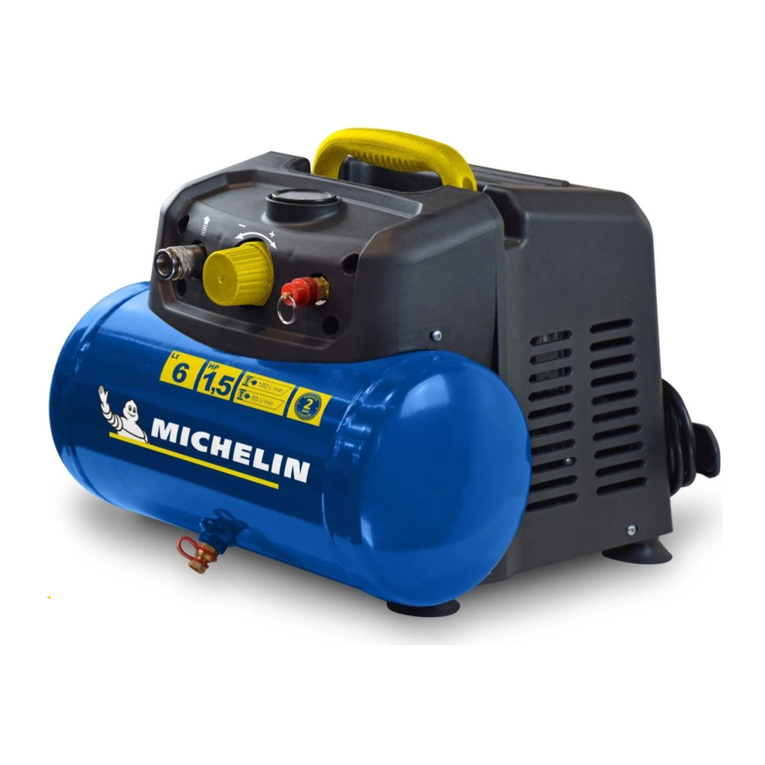
Michelin
Michelin MBL 6V2/1100 User manual

Michelin
Michelin MB Operator's manual
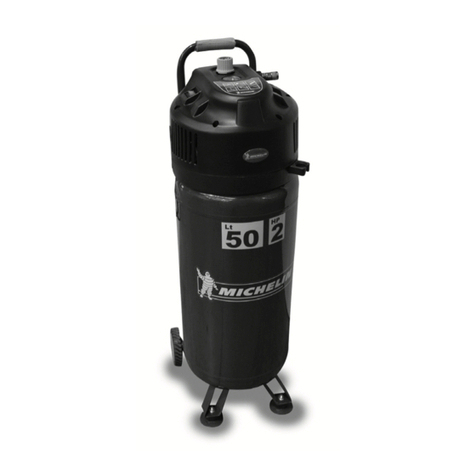
Michelin
Michelin MVX50 Operator's manual
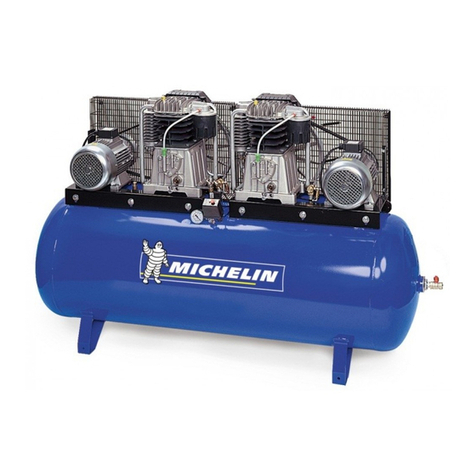
Michelin
Michelin MB 10 Operator's manual
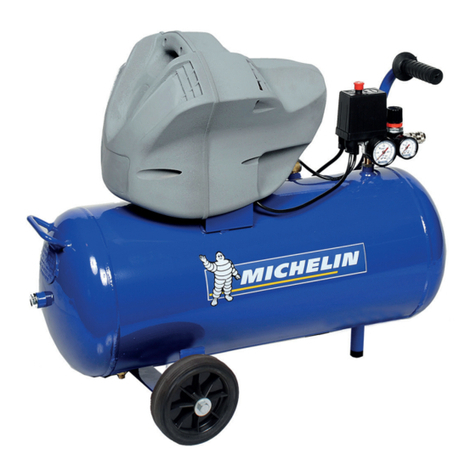
Michelin
Michelin MB 3100 U Operator's manual

Michelin
Michelin MVX 24 Operator's manual
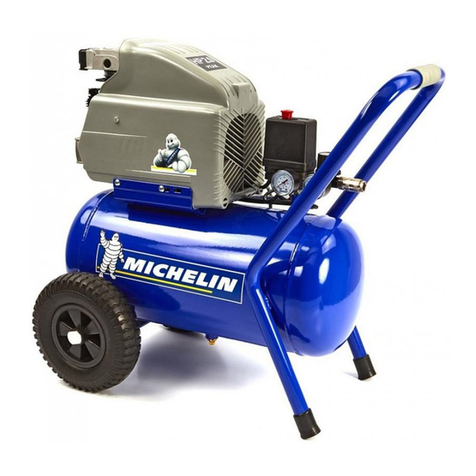
Michelin
Michelin MCX24 Operator's manual

Michelin
Michelin CA-MCX6U Operator's manual
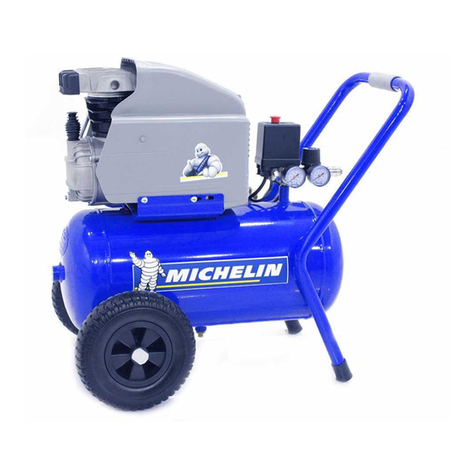
Michelin
Michelin MCX150/360 Operator's manual
